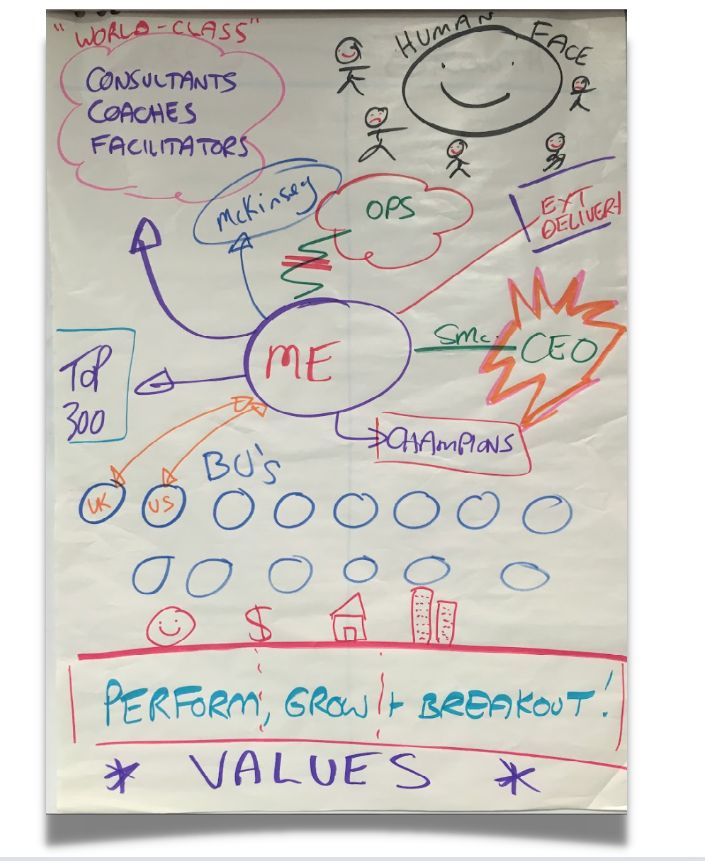Challenge Mapping

Goal
The objective of this task is to provide you with the opportunity to map your leadership challenge within the system/systems that you are a part of.
Materials
Instructions
SLIDE XX: UNDERSTANDING YOUR LEADERSHIP CHALLENGE TITLE SLIDE
SLIDE XX: NETWORKING IMAGE (as a background when introducing map exercise)

As a prelude to the Peer Consultation Process where you will be working in small groups of 3-4 (next session), you are now going to have some time to map your challenge within the context of your system.
Instructions
The objective of this task is to provide you with the opportunity to map your leadership challenge within the system/systems that you are a part of.
The ‘mental map’ we have of our system is not the organisation, but it is our perception of the organisation. The ideas have been developed over time and are based upon our experience, knowledge and learning. They form the basis of our mental maps, which guide and influence our behaviour. We seldom, if ever, examine these maps and their relevance to the world within which we are currently operating.
However, the organisation and other external factors continue to change over time and so our maps may not always reflect these changes.
The system and the organisation are not the same thing. A system is a set of relations with a boundary. Members of your system may or may not belong to your organisation. For this exercise, we will be looking at your system.
The first person in the system is you. In addition, it may include people like: people who report to you; colleagues; your manager; a spouse or other related members of your family with whom you might share information, ask for advice, confide in, or generally consult from time to time on personal business issues; suppliers/providers; clients/customers; outside consultants; government agencies; mentors etc.
These are the people, the network of relations, the system that governs or influences our everyday taking up of our roles and how we approach problems, issues and challenges.
SLIDE XX: REFLECTION/TASK (as per pre-work guidelines)
Please draw a mental map of your system (not your organisation) as it relates to your leadership challenge.
Please do not draw an organisation chart. The map should attempt to represent the various people in your system and their relation to you.
You may draw pictures, representations, symbols, or images of any kind to represent these figures and relation to you and each other. Be as creative as you can in drawing these maps. Let your mind roam as freely as possible and don’t be constricted by the need for logic or consistency. Wherever possible, try to represent their relative importance to you, their nearness or distance from your, and any other factor you feel is relevant.
SLIDE XX: SAMPLE MAP
Facilitator briefly talks through example leadership challenge map to help people understand what a map might look like (although stress that you can be as creative as you like!).
Please draw a mental map of your system (not your organisation) as it relates to your leadership challenge.

Please do not draw an organisation chart. The map should attempt to represent the various people in your system and their relation to you.
You may draw pictures, representations, symbols, or images of any kind to represent these figures and relation to you and each other. Be as creative as you can in drawing these maps. Let your mind roam as freely as possible and don’t be constricted by the need for logic or consistency. Wherever possible, try to represent their relative importance to you, their nearness or distance from your, and any other factor you feel is relevant.
NB: If the workshop is in person (f2f), hand out a piece of A2 (flip chart size) paper or more normally flip chart paper cut in half (A3 size) and coloured textas/markers to each person.
Invite them to find a comfortable place, lie on the floor, find a couch, etc. and come back in 15 mins.
You will have 15 minutes.
SLIDE XX: BREAKOUT ROOMS: SHARE YOUR LEADERSHIP CHALLENGE MAP (BRIEFLY) PAIRS (10 MINS)
Please note that it’s not about trying to solve or even diagnose yours/others’ maps. In the next session, you will have each have a chance to share your map and work further in a small group to gain insights and a possible way forward.
Attachments
- Screenshot 2024-06-28 at 3.01.56 pm.png
- Screenshot 2024-06-28 at 2.58.24 pm.png
Background
Facilitator Note: The Peer Consultation Process (PCP) coming soon in the agenda works quite well without doing the mapping exercise, so it is not mandatory. The Harvard PCP does not include mapping, however we introduced it in our NAB Adaptive Leadership Program many years ago and having people draw a map of their challenge before starting the PCP works well. Our preference is that we do the mapping, which can be a quick simple step or could be an exercise in itself. For example, we have worked with teams where we had each person draw a map of their role in the team and where the ‘role noise’ was and then present it back to the team. This is a slightly different exercise where the focus of the discussion/exercises is more about the role the case presenter is taking up and role noise.
Back to mapping for LX. From this point, you can do it in two (or more ways), and this may also depend on whether you are in person or virtual or if the group knows each other or not.
Option 1: Once people have completed their individual leadership maps (and if the group is not too big – e.g. less than 20 pax), people share their map in the whole group fairly quickly (e.g. 1-2 minutes).
This gives the whole group/team a flavour of what everyone is working on which can be very helpful. This can be particularly useful to give everyone an understanding of each person’s challenge because they are most likely part of it in some way.
Option 2: The more usual way that we do it is that rather than sharing in the whole group, people are broken into their small groups and share their map as part of the Peer Consultation Process (see below for further).
This design assumes virtual and option 2.